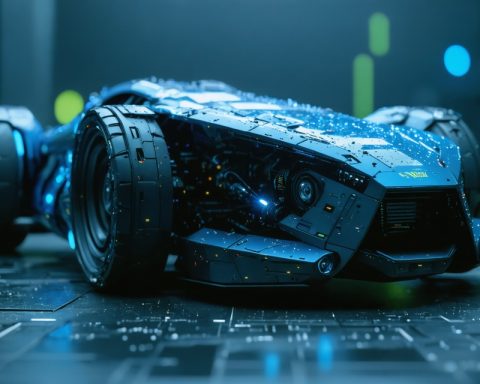- Lidar technology reduces traffic fatalities by enabling autonomous vehicles to outperform human reflexes and accuracy.
- Aeva Technologies, Inc. leads with 4D Lidar sensors that capture both the position and instant velocity of objects, enhancing vehicle perception.
- The flagship sensor, Atlas Ultra, offers three times the resolution of its predecessor and integrates seamlessly with vehicles.
- Aeva focuses on fast-adopting sectors like taxicab services and aims to revolutionize the logistics industry with autonomous trucks by 2027.
- Resilient stock recovery and strategic partnerships have driven increased investor confidence in the Lidar market.
- The fusion of artificial intelligence with Lidar technology promises safer and more efficient transportation systems.
On roads worldwide, human error too often claims lives, with 1.35 million traffic fatalities reported annually. Enter Lidar technology — the invisible eye guiding the future of autonomous vehicles. Lidar, with its laser-precise mapping capability, scans surroundings in split seconds, paving the way for transportation where machinery outperforms humans in reflex and accuracy.
Aeva Technologies, Inc., a standout in this fast-evolving landscape, turns heads with innovative 4D Lidar sensors. These sensors excel not only in detecting the position but unravel the instant velocity of objects, empowering vehicles to perceive their environment with astonishing clarity. Aeva’s flagship product, the Atlas Ultra, boasts a resolution three times superior to its predecessor and embraces a sleek design for seamless integration into passenger vehicles. By targeting fleets of taxicab services such as Waymo, Aeva hones in on sectors poised to embrace this technology rapidly.
Beyond passenger vehicles, Aeva sets its sights on the logistics industry. Partnering with Torc Robotics, a Daimler Truck subsidiary, signals an audacious leap towards bringing autonomous trucks to highways by 2027. The prospect: transforming logistics into an eco-friendlier, cost-efficient, and safer domain.
While Aeva’s stock has weathered volatility, spurred by hesitant markets post-IPO, a resilient recovery reflects burgeoning investor confidence. Analysts remain bullish, with price targets climbing as recent partnerships herald a fresh era of commercial breakthroughs.
Navigating the billion-dollar expansion of Lidar markets, the broader appeal for investors lies in the harmonization of artificial intelligence with Lidar technology. Together, they enhance data processing, curb accident rates, and redefine transportation. While Aeva propels the Lidar narrative, the race is undeniably vast, hinting at an exhilarating future where technology moves the world with unprecedented intelligence and speed.
Revolutionizing Road Safety: How Lidar Technology and Aeva’s Innovative Solutions are Paving the Way
How-To Steps & Life Hacks
Implementing Lidar Technology in Autonomous Vehicles
1. Assessment and Mapping: Begin by using Lidar to map the environment. This is crucial for robotic systems to understand spatial layout and distances.
2. Integration with AI Systems: Lidar data needs to be integrated into machine learning algorithms for real-time decision-making. These systems use neural networks to identify and predict object paths.
3. Testing Under Various Conditions: Conduct tests in diverse environments, such as urban settings and highways, under different weather conditions to ensure all-encompassing functionality.
4. Continuous Calibration: Regularly calibrate the Lidar sensors to maintain accuracy and reliability over time, considering variables such as sensor degradation or changes in environmental conditions.
5. Compliance and Safety Checks: Ensure that Lidar systems comply with local regulations and pass safety inspections through rigorous validation processes.
Real-World Use Cases
Lidar technology is transforming multiple industries beyond autonomous vehicles:
– Agriculture: Used in precision farming to map topographies and monitor crop health.
– Architecture and Construction: Provides 3D imaging of structures and helps in designing models.
– Urban Planning: Aids in developing smart cities by providing high-fidelity data for infrastructure projects.
Market Forecasts & Industry Trends
The Lidar market is expected to grow at a CAGR of 20% from 2023 to 2030. Industry trends highlight a shift towards integrating AI with Lidar systems to enhance automation capabilities and reduce human intervention link name.
Reviews & Comparisons
Compared to other providers, Aeva’s Lidar sensors offer unique 4D capabilities, capturing detailed velocity data. The Atlas Ultra outperforms competitors in resolution and design integration, tailored for passenger vehicles, and autonomous fleets.
Controversies & Limitations
Lidar technology faces challenges such as interference from external light sources and high production costs. These are critical considerations that can affect operational efficiency and affordability.
Features, Specs & Pricing
– Atlas Ultra: Features high-resolution mapping, compact design, and enhanced data processing capabilities.
– Pricing: Competitive but varies based on integration and customization needs.
Security & Sustainability
– Data Security: Lidar systems must have robust cybersecurity measures to protect against data breaches, ensuring secure transmission and storage.
– Sustainability: Energy-efficient designs and extended sensor life contribute to environmental sustainability, aligning with eco-friendly transport policies.
Insights & Predictions
Aeva’s partnership with Torc Robotics suggests a significant shift towards autonomous long-haul trucking by 2027, potentially reducing carbon emissions through optimized fuel consumption.
Tutorials & Compatibility
– Compatibility: Designed to integrate with multiple vehicle platforms and AI systems, facilitating widespread adoption.
– Tutorial Support: Aeva offers comprehensive guides and technical support to assist manufacturers and developers in integration.
Pros & Cons Overview
Pros:
– High precision and reliability.
– Revolutionary 4D mapping technology.
– Strong industry partnerships enhancing market presence.
Cons:
– Susceptibility to interference.
– High initial costs and infrastructure requirements.
Actionable Recommendations
– For Investors: Keep an eye on strategic partnerships and technology advancements to guide investment decisions.
– For Developers: Leverage Aeva’s Lidar solutions to innovate responsive and adaptive vehicle systems.
– For Consumers: Understand the significance of Lidar in improving vehicle safety and eco-efficiency.
Discover more about Aeva and its pioneering role in the Lidar industry at link name.















